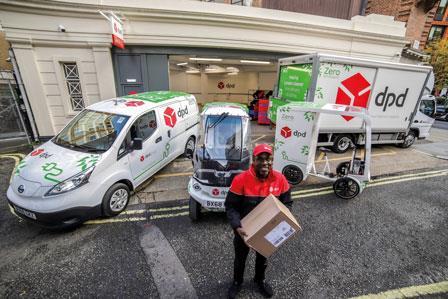
Parcel firm DPD is redefining the way it operates within an urban environment to ensure its fleet of 8,000 delivery vehicles reduce their impact on air quality, noise levels and road safety.
With 46% of parcels now destined for city centres, DPD’s Urban Delivery Strategy has seen the launch of a network of micro-depots with all-electric trunking, alongside a wider expansion of its electric fleet to 732 vehicles by the end of 2020. This number has since increased to 800.
One advantage of serving city centres is that drop densities are much higher than in rural areas, making the operation more efficient and more suited to electric vehicles’ limited range.
“Comparing London with rural Sussex, for example, it would work out at around 250 stops per day in the City of London versus around 85 in the Sussex countryside,” says DPD head of CSR Olly Craughan. “Our new route optimisation software – a big factor in DPD winning the Best Use of Technology Award – means we now make a delivery every 0.93 miles versus every 1.02 miles, an improvement of 9% in the last two years.”
Its first two micro-depots opened in Westminster and Shoreditch in London during 2019 and between them have produced an emissions reduction of 95.8 tonnes of CO2 per annum.
Before Westminster, DPD’s 63,000sq ft London City depot (in Southwark) was sending 15 3.5-tonners into London every day and clocking up 614 miles, whilst before Shoreditch the firm’s 37,500sq ft Barking depot was sending 20 3.5-tonne diesel vehicles into central London every day, clocking up 773 miles.
Thanks to DPD’s all-electric vehicles and micro-depot strategy, its miles travelled per parcel have been almost halved and this more efficient operation now produces just 0.138 tonnes of CO2 per month versus 8.67 tonnes of CO2 before the sites opened – an incredible 98.96% reduction.
This reduction in CO2 emissions has also been helped by a fall-off in traffic congestion – but this is now returning as commuters return to work.

“TfL’s measures were good at lowering private mileage congestion before the pandemic, but now with people reluctant to use public transport, single-occupancy car journeys have increased,” says Craughan, pictured. “Our goal of course is not to reduce volumes into city centres, but to carry them on zero-emission vehicles, thus improving air quality.”
A third micro-depot is now running in Hyde Park, with a total of eight planned across the capital. To locate these, DPD is encouraging local authorities to think out of the box when it comes to using buildings that are under-utilised or unoccupied as a result of the pandemic.
“We are talking to a couple of potential partners – both public and private – who previously wanted to charge us very steep fees to operate a DPD micro-depot, but who are now looking to repurpose their real estate and attract alternative revenue streams,” says Craughan.
Wide appeal
Outside of the capital, the business has been rolling out its urban strategy with 800 electric vans now located at 84 depots nationally, which DPD says has been hugely positive. In 2020, the company delivered 11.2 million parcels on EVs, up from just 1.3 million in 2019 and the goal now is to hit 100 million by 2025. With 10% of the fleet now electric, CO2 emissions are reduced by 5,000 tonnes a year, the equivalent of planting 20,000 trees.
“We now have three all-electric depots in London and one in Hull,” says Craughan. “We are aiming to have 10 in London as soon as possible. Our latest London micro-depot opened in November 2020 in a car park at the bottom of Park Lane, which involved an innovative partnership with the operator, Q-Park.
“But we faced numerous bureaucratic barriers to get permission to operate there. Opening our first two sites in Westminster and Shoreditch wasn’t plain sailing either. To be frank, we’d like to move faster in the capital and open more all-electric micro-sites more quickly, which is why we’ve repeatedly called on local and national government to cut red tape and make it easier for all operators to go green. Finding sites is a challenge due to rents in London, so we are actively looking for strategic partnerships with landlords.”
Pushing the boundaries
As the range of electric vehicles increases, will DPD eventually be able to close some of these new sites and consolidate into larger depots again?
“We’d need a crystal ball to answer that question!” says Craughan, “Much will depend on how quickly EV batteries evolve, but at the moment we think there’ll always be a place for sites that are close to customers and where there’s an opportunity to reduce emissions through short stem mileage.”

A pioneering approach to its fleet has seen DPD source all-electric Paxster micro-vehicles from Norway, while at the same time developing an eCargo bike in partnership with UK start-up EAV.
It was first in line to secure a 100-strong order of the new 3.5-tonne MAN eTGE. DPD said this size of vehicle is the ‘workhorse’ of the operation and the firm has been keen to see variants come to market for a long time – so much so that it will be taking left-hand-drive vehicles initially to be converted in the UK.
To avoid having to recharge batteries during a delivery round, DPD is matching vehicle range to length of route, says Craughan: “Operational planning means we allocate our EVs to the lowest mileage routes, so our initial approach nationwide has been to go for that ‘lower hanging fruit’.”
It is not just the final mile that DPD has been electrifying. It had two FUSO eCanters when there were only 10 in the whole UK at the time and these are still used to trunk parcels from a huge DC in Southwark to the company’s Westminster micro-depot.
DPD has made no secret of its frustration at the lack of availability of larger non-diesel vehicles with a range that will enable it to trunk parcels from its national sortation hubs in Oldbury and Hinckley to London without emitting CO2.
“The pace of progress here is frustrating, but we are currently trialling a bio-methane tractor unit which produces 80% less CO2 than diesel,” says Craughan. “We also have to bear in mind that having the biggest fleet of double-deck trailers in the UK (a choice we made many years ago for environmental reasons) has implications for battery power.
“There will be several announcements in the sustainability space coming soon! Our dedicated green website keeps all stakeholders up to date on our latest developments [green.dpd.co.uk].”
The move to electric delivery vehicles has raised concerns about how drivers who take their vehicles home at night can recharge them. This is especially a problem in central London, where relatively few people have access to private drives and garages to plug in vehicles.
“We’ve invested nearly £70,000 so far to install electric vehicle home chargers for our drivers, so that’s where 60% of the charging happens,” says Craughan. “The other 40% is in the depot or at public charging points – where we would welcome more urgency from the government in terms of building the infrastructure.”
This investment in home chargers means that large and expensive upgrades to depot electrical infrastructure have not been necessary so far. DPD has selected Pod Point as its in-depot smart-charging supplier.
DPD has also rolled out essential driver training for new electric technology, as well as supporting drivers to adopt home-charging systems with funding of £250 and help to access a further £500 government grant. It continues to focus on safety, ensuring full compliance with London’s incoming Direct Vision Standard and vulnerable road user awareness.
Judges said: “This was a very strong entry from DPD. A great use of technology and different operating models to protect the urban environment. Also impressed to see them encouraging home charging by drivers – this is challenging and has not been trialled by many.”










